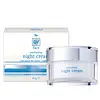What's inside
What's inside
 Key Ingredients
Key Ingredients

 Benefits
Benefits

 Concerns
Concerns

 Ingredients Side-by-side
Ingredients Side-by-side

Water
Skin ConditioningCaprylic/Capric Triglyceride
MaskingCetearyl Alcohol
EmollientGlycerin
HumectantPrunus Amygdalus Dulcis Oil
Skin ConditioningCetyl Alcohol
EmollientMacadamia Ternifolia Seed Oil
EmollientSodium Acrylate/Sodium Acryloyldimethyl Taurate Copolymer
Emulsion StabilisingIsohexadecane
EmollientPolysorbate 80
EmulsifyingBeta-Glucan
Skin ConditioningCetearyl Glucoside
EmulsifyingPentylene Glycol
Skin ConditioningSodium Lactate
BufferingLactic Acid
BufferingSerine
MaskingUrea
BufferingSorbitol
HumectantSodium Chloride
MaskingAllantoin
Skin ConditioningRosa Moschata Seed Oil
EmollientAvena Sativa Kernel Meal
AbrasiveHydrolyzed Oat Flour
Skin ConditioningPhenoxyethanol
PreservativeCaprylyl Glycol
EmollientTriethanolamine
BufferingBenzyl Alcohol
PerfumingSorbic Acid
PreservativeAmmonium Acryloyldimethyltaurate/Vp Copolymer
Disodium EDTA
Tocopheryl Acetate
AntioxidantSorbitan Oleate
EmulsifyingWater, Caprylic/Capric Triglyceride, Cetearyl Alcohol, Glycerin, Prunus Amygdalus Dulcis Oil, Cetyl Alcohol, Macadamia Ternifolia Seed Oil, Sodium Acrylate/Sodium Acryloyldimethyl Taurate Copolymer, Isohexadecane, Polysorbate 80, Beta-Glucan, Cetearyl Glucoside, Pentylene Glycol, Sodium Lactate, Lactic Acid, Serine, Urea, Sorbitol, Sodium Chloride, Allantoin, Rosa Moschata Seed Oil, Avena Sativa Kernel Meal, Hydrolyzed Oat Flour, Phenoxyethanol, Caprylyl Glycol, Triethanolamine, Benzyl Alcohol, Sorbic Acid, Ammonium Acryloyldimethyltaurate/Vp Copolymer, Disodium EDTA, Tocopheryl Acetate, Sorbitan Oleate
Cyclopentasiloxane
EmollientGlycerin
HumectantCarthamus Tinctorius Seed Oil
MaskingPetrolatum
EmollientParaffinum Liquidum
EmollientGlyceryl Stearate
EmollientPEG-100 Stearate
Cetearyl Alcohol
EmollientNiacinamide
SmoothingDimethicone
EmollientMethylparaben
PreservativePropylparaben
PreservativeSodium Polyacrylate
AbsorbentTocopherol
AntioxidantDichlorobenzyl Alcohol
AntimicrobialCitric Acid
BufferingIngredients Explained
These ingredients are found in both products.
Ingredients higher up in an ingredient list are typically present in a larger amount.
Cetearyl alcohol is a mixture of two fatty alcohols: cetyl alcohol and stearyl alcohol. It is mainly used as an emulsifier. Emulsifiers help prevent the separation of oils and products. Due to its composition, it can also be used to thicken a product or help create foam.
Cetearyl alcohol is an emollient. Emollients help soothe and hydrate the skin by trapping moisture.
Studies show Cetearyl alcohol is non-toxic and non-irritating. The FDA allows products labeled "alcohol-free" to have fatty alcohols.
This ingredient is usually derived from plant oils such as palm, vegetable, or coconut oils. There is debate on whether this ingredient will cause acne.
Due to the fatty acid base, this ingredient may not be Malassezia folliculitis safe.
Learn more about Cetearyl AlcoholGlycerin is already naturally found in your skin. It helps moisturize and protect your skin.
A study from 2016 found glycerin to be more effective as a humectant than AHAs and hyaluronic acid.
As a humectant, it helps the skin stay hydrated by pulling moisture to your skin. The low molecular weight of glycerin allows it to pull moisture into the deeper layers of your skin.
Hydrated skin improves your skin barrier; Your skin barrier helps protect against irritants and bacteria.
Glycerin has also been found to have antimicrobial and antiviral properties. Due to these properties, glycerin is often used in wound and burn treatments.
In cosmetics, glycerin is usually derived from plants such as soybean or palm. However, it can also be sourced from animals, such as tallow or animal fat.
This ingredient is organic, colorless, odorless, and non-toxic.
Glycerin is the name for this ingredient in American English. British English uses Glycerol/Glycerine.
Learn more about Glycerin